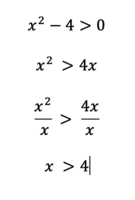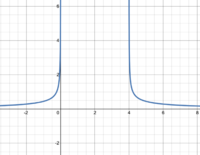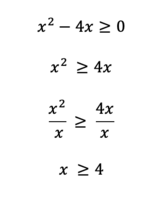The domain of the following function is [MATH](-infinity, 0)u(4, infinity)[/MATH]:
[MATH]f(x) = 1/(sqrt(x^2-4x))[/MATH]
My question is how do you find the domain algebraically? I used the following to find the [MATH](4, infinity)[/MATH] part:
[MATH]x^2 >= 4x[/MATH]
but can't figure out how to algebraically find the [MATH](-infinity, 0)[/MATH] part. I understand that it's right, I just can find it formulaically.
[MATH]f(x) = 1/(sqrt(x^2-4x))[/MATH]
My question is how do you find the domain algebraically? I used the following to find the [MATH](4, infinity)[/MATH] part:
[MATH]x^2 >= 4x[/MATH]
but can't figure out how to algebraically find the [MATH](-infinity, 0)[/MATH] part. I understand that it's right, I just can find it formulaically.




